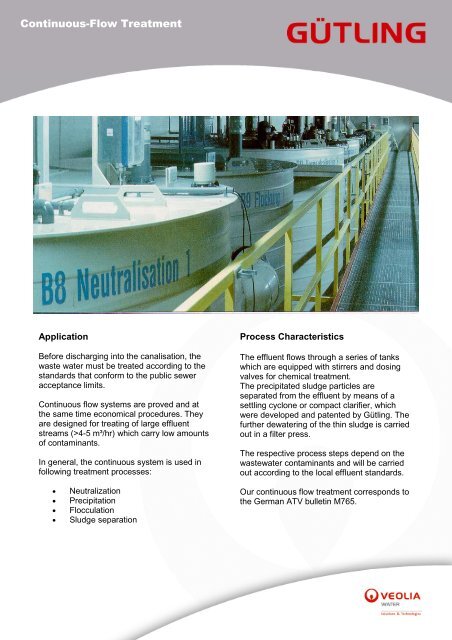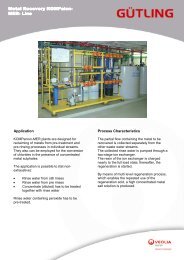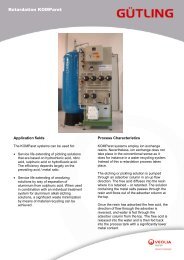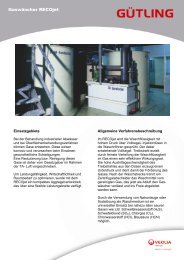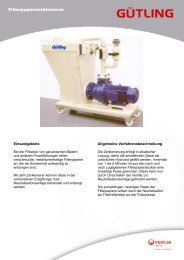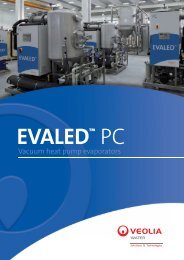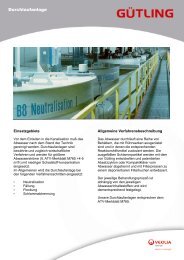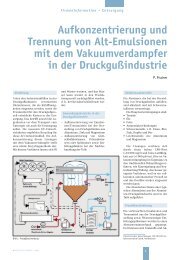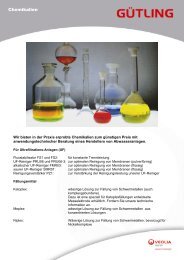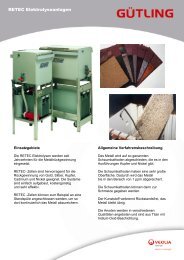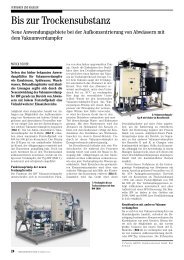Continous Treatment - Gütling Wassertechnologie GmbH
Continous Treatment - Gütling Wassertechnologie GmbH
Continous Treatment - Gütling Wassertechnologie GmbH
You also want an ePaper? Increase the reach of your titles
YUMPU automatically turns print PDFs into web optimized ePapers that Google loves.
Continuous-Flow <strong>Treatment</strong><br />
Application<br />
Before discharging into the canalisation, the<br />
waste water must be treated according to the<br />
standards that conform to the public sewer<br />
acceptance limits.<br />
Continuous flow systems are proved and at<br />
the same time economical procedures. They<br />
are designed for treating of large effluent<br />
streams (>4-5 m³/hr) which carry low amounts<br />
of contaminants.<br />
In general, the continuous system is used in<br />
following treatment processes:<br />
• Neutralization<br />
• Precipitation<br />
• Flocculation<br />
• Sludge separation<br />
Process Characteristics<br />
The effluent flows through a series of tanks<br />
which are equipped with stirrers and dosing<br />
valves for chemical treatment.<br />
The precipitated sludge particles are<br />
separated from the effluent by means of a<br />
settling cyclone or compact clarifier, which<br />
were developed and patented by <strong>Gütling</strong>. The<br />
further dewatering of the thin sludge is carried<br />
out in a filter press.<br />
The respective process steps depend on the<br />
wastewater contaminants and will be carried<br />
out according to the local effluent standards.<br />
Our continuous flow treatment corresponds to<br />
the German ATV bulletin M765.
Continuous-Flow <strong>Treatment</strong><br />
Inlet<br />
Storage tank<br />
Description of the plant<br />
The waste water is buffered in a storage tank in order to equalise the fluctuation of concentration and<br />
volume flow. The waste water is transferred with a pumping station to the intake height of the<br />
continuous treatment unit. The effluent flows at free slope without any shear stress. Depending on the<br />
available installation height and the kind of the arising sludge, the sludge can be separated by means of<br />
a settling cyclone or a compact clarifier. The separated wet sludge can be further compacted in a<br />
sludge thickener.<br />
A chamber filter press is usually used to dewater the sludge to a depositable dry sludge. In special<br />
cases, a membrane filter press can also be used.<br />
In certain critical applications, the use of a sandfilter in combination with a selective ion exchanger is<br />
indicated.<br />
<strong>Gütling</strong> <strong>Wassertechnologie</strong><br />
Merowingerstraße 7<br />
D - 70736 Fellbach<br />
Tel.: + 49 (0) 711/518550 – 0<br />
Fax: + 49 (0) 711/518550 – 220<br />
www.guetling.com<br />
guetling@veoliawater.com<br />
Chemicals<br />
p H<br />
M p H<br />
Chemicals Flocculant<br />
Advantages<br />
pH<br />
M pH M<br />
Flotat<br />
Clarified<br />
effluent<br />
Flow treatment Settling cyclone,<br />
alternatively compact<br />
clarifier<br />
Thin sludge<br />
• Processing of high waste water volumes with low<br />
pollutant concentration<br />
• Continuous process<br />
• Little floor space requirements<br />
• Standard dimensions<br />
• Corrosion-resistant construction<br />
• High standard of automation<br />
• Low operating costs<br />
• Sludge separation and pre-thickening in one system<br />
12/2008


